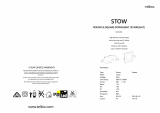
11
VCG Royalton Series • BE36/42 • 4044-197 Installation Manual • Rev A • 02/18/15
C. Construct the Chase
A chase is a vertical boxlike structure built to enclose the
replace and/or its vent system. Vertical chimneys that
run on the outside of a building must be installed inside a
chase.
In cold climates, Vermont Castings Group recommends
that the chase be well insulated using batt type insulation
between the joists.
Construction of the chase may vary with the type of build-
ing. These instructions are not substitutes for the require-
ments of local building codes. Local building codes MUST
be checked.
Chases should be constructed in the manner of all outside
walls of the home to prevent cold air drafting problems. The
chase should not break the outside building envelope in
any manner. All outer walls need to be insulated.
Building codes require false ceiling and ceiling restops/
attic shields at each oor of the chase or every 10 ft (3048
mm) of clear space to control spread of re.
Walls, ceiling, base plate and cantilever oor at the rst
level of the chase should be insulated (see Figure 3.3.)
Vapor and air inltration barriers should be installed in the
chase as per regional codes for the rest of the home. Ad-
ditionally, Vermont Castings Group recommends that the
inside surfaces be drywalled and taped (or the use of an
equivalent method) for maximum air tightness.
Holes and other openings should be caulked with high tem-
perature caulk or stuffed with unfaced berglass insulation.
Ceiling
Firestop
Metal Chase Top
Round Termination Cap
False Ceiling
Insulation in the
outside walls
of the chase
Attic
Insulation
Shield
Chimney
Ceiling
Firestop
Tabs
False Ceiling
False Ceiling
Insulation
Insulation
Figure 3.3 Chase Assembly
123
1. Fireplace and chimney enclosed in an exterior chase.
2. Chimney offset through exterior wall and enclosed in chase.
3. Chase constructed on roof.
Note: In cooler climates, all chase walls should be insulated.
Figure 3.4 Chase Constructions
• The chase is constructed using framing materials much
the same as the walls in your home. A variety of siding
materials may be used including brick, stone, veneer
brick, or standard siding materials.
• In constructing the chase, several factors must be
considered:
- Maintain a 2 in. (51 mm) air space around the
chimney.
- The chase top must be constructed of non-
combustible material.
- In cold climates, a restop spacer and attic insulation
shield should be installed in an insulated false ceiling
at the 8 ft. (2438 mm) level above the replace
assembly. This reduces heat loss through the chase.
- In cold climates, the walls of the chase should be
insulated to the level of the false ceiling as shown in
Figure 3.3. This will help reduce heat loss from the
home around the replace.
Three examples of chase applications are shown in Fig-
ure 3.4.
WARNING! You must install false ceilings and ceil-
ing restops at each oor of the chase or every 10 ft
(3.05 m) to control spread of re.
WARNING! Risk of Fire! DO NOT sealareabetweenre
stop opening and chimney pipe except where they enter
theatticorleavethewarmairenvelopeofthehome(use
600°Fsealant).
WARNING! Risk of Fire! You must maintain a mini-
mum 2 in. (51 mm) air space clearance to insula-
tion and other materials surrounding the chimney
system.
• Insulationandothermaterialsmustbermlysecuredto
prevent accidental contact with chimney system.
• Thechasemustbeproperlyblockedtopreventblown
insulation or other combustibles from entering and
makingcontactwithreplaceorchimney.
• Failuretoprevent contactbetween insulationor other
materials and chimney system may cause overheating
andre.





















